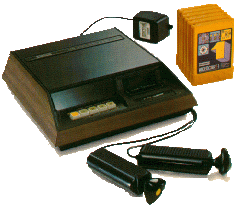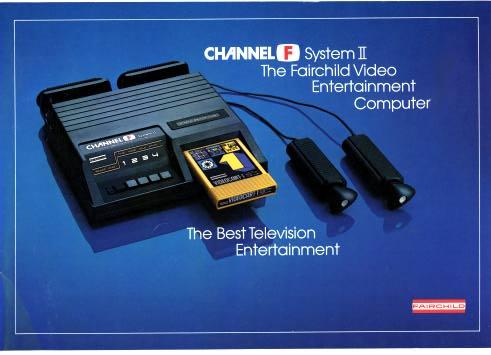Fairchild Channel F
|
|

|
| Channel F |
The Fairchild Channel F is the world's first cartridge-based video game console. It was released by Fairchild Semiconductor (ostensibly by their parent company though) in August 1976 at a cost of $169.95. At this point it was known as the Video Entertainment System, or VES, but when Atari released their VCS the next year, Fairchild quickly re-named it.
| Contents |
The Channel F console
The Channel F was based on the Fairchild F8 CPU, invented by Robert Noyce before he left Fairchild to start his own company, Intel. The F8 was so early that the process technology of the era couldn't fit all the needed circuitry onto a single chip, and the F8 was in fact a "family" of chips that had to be wired together to form a complete CPU. The video was quite basic, although it was in color which was a large step forward from the contemporary PONG machines. Sound was played through an internal speaker, rather than in the TV.
The controllers were a kind of joystick without a base; the main body was a large hand grip with a triangular "cap" on top, the top being the portion that actually moved. It could be used as both a joystick and paddle (twist), and pushed down to operate as a fire button. The unit contained a small compartment for storing the controllers when moving it: useful because the wiring was notoriously flimsy and even normal movement could break it.
Only 20 cartridges were released for the system (typically at $19.95), despite its initial popularity. However, the games are generally universally detested. One reviewer described the racing game (every system seemed to have one at the time) as something like losing a toe in an industrial accident.
The biggest effect of the Channel F in the market was to spur Atari into releasing their next-generation console that was then in design. Currently named "Stella" the machine was also going to use cartridges, and after seeing the Channel F they realized they needed to get it out as soon as possible before the market was flooded with cartridge based machines. With cash flow dwindling as sales of their existing Pong-based systems dried up, they were forced to sell to Warner Communications in order to gain the capital they needed. Naming their system as a takeoff of the VES, when the Atari VCS was released a year later it had considerably better graphics.

|
| Channel F System II |
The Channel F System II
Fairchild decided to compete with the VCS, and started a re-design as the Channel F System II. The major changes were in design, the controllers were removable from the base unit instead of being wired directly into it, the storage compartment was moved to the rear of the unit, and the sound was now mixed into the TV signal so the unit no longer needed a speaker. This version featured a simpler and more modern-looking case design. However by this time the market was in the midst of the first video game crash, and Fairchild eventually threw in the towel and exited the market.
Some time in 1979 Zircon International bought the rights to the Channel F and released the Channel F System II. Only six new games were released after the release of the second system before its death, several of which were developed at Fairchild before they sold it off.
A number of licensed versions were released in Europe, including the Luxor Video Entertainment System in Sweden, Adman Grandstand in the UK, and the Saba Videoplay, Nordmende Teleplay and ITT Tele-Match Processor, from Germany.
Technical specifications
- CPU chip: Fairchild F8 operating at 1.79 MHz
- RAM: 64 bytes, 16 kilobytes VRAM
- Resolution: 128 × 64 pixels, 102 × 58 pixels visible
- Colors: eight colors (four color max. per line)
- Audio: 500 Hz, 1 MHz, and 1.5 MHz tones (can be modulated quickly to produce different tones)
- Input: two custom game controllers, hardwired to the console
- Output: RF modulated composite video signal, cord hardwired to console
External links
- Fairchild Channel F at
OLD-COMPUTERS.COM(http://www.old-computers.com/museum/computer.asp?c=890) - Channel F FAQ from rec.games.video.classic (http://zappa.brainiac.com/cdyer/faqs/fairv2.htm)
- The MESS Project (http://www.mess.org/) (with Channel F emulation)de:Channel F
